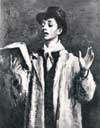Press Review piosantini]

Santini has been influenced by Paris and kept the high Italian tradition.
Adolphe de Falgairolle
A very stable painter, who nourished himself with the best from the French 19th tradition. His work reveals fauvism’ colours, pre-impressionist grace and Degas’s elegance.
Alberto Longa
A sound professional in painting, Santini the Italian vigorously expresses the world’s poetry. We can feel strength in his expression, in the way he gathers his drawing and plays with the opposite tonalities; and he shows a great delicacy with the play of light on a river.
Jean Delavèze
“Pio Santini. A painter who has such a strong sense of the fantastic ! How uncommon !”
Colette
“He is the sort of painter you do not find very often, whose modesty is the main feature. I mean that Pio Santini does not think of himself but of nature, men, when he is painting. His paintings are as humble as prayers. He is good with his hands, he has an in-depth professional touch, a good eye for the forms, a keen sense of the light’s caress. His appropriate strokes and his palette’s range without any dubious tones are not spoilt with tricks.
We are in the presence of a lucid painter whose style is wholly inner, wholly pure and thus without any ambiguity. His works, well! they are a festival for the eye and the spirit.”
Jean Chabanon
“Pio Santini knows that the artist is, all at the same time, intelligence, sensitivity, sensuality, dream and reason. Its painting harmonizes all that while offering to all faculties of the man and the artist their rich person blooming. In its tables, the things are there, such as it likes them, with their heat and solid matter, chatoyant glare to them, but there is also what one can call it beyond the things, their secret heart, and the manner that they have to be thought ellemêmes and to think the rest of the world.”
Marcel Brion de l'Académie Française
“I have followed the artistic evolution of my friend Pio Santini for years with great interest and sympathy and his genuinely strong and sincere art displays every feature likely to touch anyone who appreciates the poetic essence of reality. There is the visible world and the invisible world; between them, no arbitrary barriers, no artificial limits. Everyone, either dreaming or daydreaming, can make his/her way from one the other, no one else but the artist and the poet is able to interpret the lack of realism of reality and the reality of unreality.
Pio Santini adheres to the earth with all the strength of his senses and reason, he likes objects for their shape, colour and flesh. He is very far from abstraction towards which neither his nature nor his spirit are inclined and he has such a liking for things that he cannot stop representing them. But he cannot represent them just as they are, with prosaic and easy naturalism which is as unfamiliar to his temperament as any geometrical intellectualisation would be.
Marcel Brion
 “The
painting I admired most in his beautiful exhibition, is “a family
on a sunny boat”, gliding over luminous ans subtle water such as
Monet likes mainting in Giverny. A fundamental, well grounded style
emphasized and embellished by rich and purposegul colours, a skill
indoubtedly constant but thought through over.”
“The
painting I admired most in his beautiful exhibition, is “a family
on a sunny boat”, gliding over luminous ans subtle water such as
Monet likes mainting in Giverny. A fundamental, well grounded style
emphasized and embellished by rich and purposegul colours, a skill
indoubtedly constant but thought through over.”
Marcel Espiau
Una definizione si fa per genere prossimo e differenza specifica. Lo specifico del pittore romano Santini: fedeltà a se stesso, e quindi alla terra di cui è espressione millenaria. Da più di vent'anni a Parigi, dove assimilava, con accorta scelta, grazie al profondo mistero di ogni radice, anche i migliori insegnamenti dell'evoluzione francese, egli ritestimonia, pudico, rigoglioso e paziente, in una epoca di transizione drammatica e di transazioni sconcertanti, che l'arte - dei colori o dei suoni, delle forme o del verbo - è il dramma dell'anima: cioè la vera Storia della storia degli uomini.
Mario Bergamo
Prev | Next Pio Santini – Taking pride in painting


 All
All Search
Search Recent
Recent Top 10
Top 10